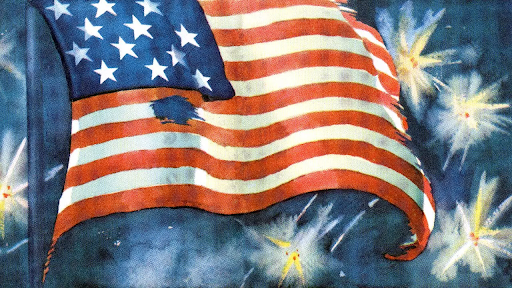Split Perspectives: Should “The Star Spangled Banner” Remain the National Anthem?
Two writers share different ideas about what to do with the current anthem.
April 21, 2023
Since 1931, the United States has officially used “The Star Spangled Banner,” written by Francis Scott Key in 1814, as its national anthem. Since then, the country has continued to debate whether this is the right choice—and what the alternatives are if it isn’t.
This week, Canon Grant is writing in defense of “The Star Spangled Banner,” and Carsten Oyer is writing to advocate replacement. They agree that it has strengths and flaws, but both differ on whether those flaws are disqualifying. They have each written different articles on their positions on the subject. Grant and Oyer hope that readers come to their own conclusions about what they believe on the subject.
An Ode to “The Star Spangled Banner”
“The Star Spangled Banner” is synonymous with apple pie, fireworks, and Fourth of July barbeque. According to the History Channel, it was written by Francis Scott Key during the Battle of Baltimore to commemorate the victory of the American garrison at Fort McHenry. The poem was put to an English drinking song called “To Anacreon in Heaven.” In 1916, Woodrow Wilson made the song the country’s anthem, and in 1931 it was made the official national anthem by Congress. This song is the quintessential piece that represents America to its core: it promotes resilience, freedom, and unity. However, in the modern day, the merit of the national anthem is being called into question. It has been called difficult to sing, to memorize, and to defend from allegations of racism. Despite all this, “The Star Spangled Banner” should continue to represent America at ballparks, celebrations, and the world stage as it clearly embodies the American spirit.
When the poem was written, it was not made to make money or to garner fame—at least that’s what David Hildebrand wrote in The Guardian. It was created out of pure emotion and relief. When Key penned the words to the song in question, he wrote with passion about the joy he felt when he saw the American flag still waving and his love for his country. It is a song of perseverance and fight that captures the American spirit both during the War of 1812 and today. When the national anthem plays, it tells everyone that we can overcome any challenge, whether that be British injustice, the threat of fascism, or even the injustices committed in our own nation against historically oppressed groups. The national anthem is also a song of unity, applying no matter your gender, creed, or race. While Key and the United States may have had a dark past, the values of the United States and the anthem that it represents transcends the evils perpetrated in the past. When “The Star Spangled Banner” is sung, it is for all Americans.
An opinion piece for the Miami Herald put it best when it was written as far back as 2020, when Colin Kapernick along with several others kneeled during the national anthem. The national anthem isn’t just a song played before sporting events and other celebrations. It represents American culture, “an ideal we strive for.” “The Star Spangled Banner” is a cultural icon ingrained in America, just as baseball, the superbowl, and the Dodge Challenger are. And just as American culture varies, Jimi Hendricks played “The Star Spangled Banner” on his electric guitar and José Feliciano sang a folk version of the song at the 1968 World Series during the Vietnam War. “The Star Spangled Banner” is a testament to the beauty and diversity of American culture.
James Madison, George Washington, and Thomas Jefferson were all Founding Fathers and all slave holders. In spite of their slaveholding, the work they did in creating America was substantial. The words “All men are created equal” eventually came to fruition after years of fighting, marching, and activism. America certainly has blood on its hands, from the slaughter of Wounded Knee to the dropping of the atomic bomb. But like those Founding Fathers, there is something that separates America from being the villain of history. The difference between good and evil is a simple one: evil chooses not to change. It says to itself that it is fine the way it is, that it is perfect. Good, however, is aware of its flaws and wishes to change. America is thus good in its progressive fight to right its wrongs. Francis Scott Key, like those Founding Fathers, was a slave holder. He sometimes even fought against the cause of abolition as a lawyer. That should not spoil the universal values espoused by the current national anthem.
The Intercept, a left-wing news source, wrote an article about the apparent racism in the third stanza of “The Star Spangled Banner”:
No refuge could save the hireling and slave
From the terror of flight or the gloom of the grave
And the star-spangled banner in triumph doth wave
O’er the land of the free and the home of the brave.
However, the writer admits to the fact that “hireling and slave” was a term used to describe those who served the monarch. The history isn’t particularly questionable; this part seems unlikely to be a defense of slavery. And while “The Star Spangled Banner” is hard to sing, that should be no reason to replace it. What does that say about America if we replace our national anthem because it’s “too difficult”? If anything, the difficulty is a testament to American strength. If “The Star Spangled Banner” was replaced, what would take its place? “The Battle Hymn of the Republic” is too militaristic and ecclesiastical for a secular nation that wishes to spread peace across the globe. “America the Beautiful” is too peaceful and solemn for a nation that wants to spread peace across the globe, and while these songs are great and amazing, they just don’t have what “The Star Spangled Banner” has. When the current anthem plays, it unites us, fills us with resolve, and imbues us with love for our country.
“The Star Spangled Banner,” despite its flaws, is the song that best represents America. It is the song of baseball and football, the song of a mother’s homemade apple pie, the song of the grand ol’ flag, and the song of unity, reliance, and patriotism. Replacing it now would be a mistake; it’s the best national anthem available.

O Say Can You See a New National Anthem?
When one thinks of a national anthem, it’s reasonable to expect a song that represents the values of those who proudly sing it. In America, though, that is not the case. For as long as anyone can remember, “The Star Spangled Banner” has been the song played at sporting events, military functions, and in patriotic displays; contrary to its use, however, it could be a lot better. Replacing this song is vital to ensuring that the United States stays true to its founding principles in the modern day.
“The Star Spangled Banner” was originally a poem by American lawyer Francis Scott Key, according to the Smithsonian Magazine. Written in 1814 while America was embroiled in the War of 1812 against Great Britain, the now-song displays the Battle of Baltimore and bombardment of Fort McHenry. At the time of the battle, Key was a temporary detainee of the British being held to prevent military secrets about the battle from being divulged. Although the assault was intense, the Americans remained in control of the fort by morning, winning the battle. The poem, started while Key was still being held, captures the triumph of American resistance and the glory of the flag, which made it popular throughout 19th and 20th century America. According to Britannica, the United States made the song the national anthem in 1931.
Although the poem itself is certainly well-written and deserving of literary recognition, hailing it as the national anthem is a mistake. Firstly, singing it is quite difficult. The train of thought of the first stanza is begun with a massive, sprawling, confusing run-on sentence. Of course, such is the nature of poetry, but comprehending it is made exceedingly difficult by the fact that the action being performed by the item with broad stripes and bright stars comes at the very end of the sentence. For four lines, the reader struggles to determine exactly what the poem is describing. It is this lengthy segment that makes the anthem so difficult to memorize; anthems ought to be succinct and clear enough to be easily known and sung. The rest of the poem is better, but it brings up another problem: without an understanding of the historical situation of the poem, “O say can you see” and “O say does that star-spangled banner yet wave / O’er the land of the free and the home of the brave?” sounds eerily similar to questioning whether the flag still flies over the same country as when Key wrote it. Although that has political connotations, including such a loaded discussion in a national anthem is worrying. Furthermore, the only part of the song that meaningfully addresses American principles is “O’er the land of the free and the home of the brave?” which is not particularly insightful into what it really means to be an American.
With a national anthem as poor as “The Star Spangled Banner,” replacement is obvious. How to do so is less obvious, though. There is a great deal of music and poetry, both old and more contemporary, about America that could potentially work as a national anthem. To find a strong substitute, it is necessary to look at four factors: national meaning, strong and easily understood writing, good music or the ability to be set to music, and mainstream popularity in American culture. The piece that most amply meets these conditions is most deserving of the coveted role in American life.
My first instinct is to examine “America the Beautiful.” This song is relatively brief lyrically (much like “The Star Spangled Banner,” though, it has more stanzas than are traditionally sung) and is a mainstream “patriotic” song. The piece examines what makes America beautiful, beginning with its natural environment in such a way that intrinsically promotes conservationism. The song then extends that to the fraternity of Americans “from sea to shining sea,” providing a uniting vision for a diverse and varied population. Combined with the soaring vistas imagined at the beginning, this provides a strong national meaning to the song that would validate it as the national anthem. “America the Beautiful” isn’t perfect though — for one, those “amber waves of grain” were only secured by a legacy of American imperialism and abuse of indigenous peoples, and the song offers little reconciliation for that. Additionally, the line “God shed His grace on thee,” could be seen as too religious for a government wishing to claim separation of church and state; even if it’s deemed a metaphor, that could be enough to prevent the song’s acceptance.
The best choice for a new national anthem comes from a song that is already well-known in some circles. Americans already hear it at the Superbowl. Often referred to as the Black national anthem, according to CNN, “Lift Every Voice and Sing” was written by the first African American head of the National Association for the Advancement of Colored Peoples (NAACP) and his brother. Written to proclaim racial justice, equality, and the full guarantee of American principles to all people, this song is as African-American as it is simply American.
The first stanza, which would be adopted in this hypothetical situation, includes not only mention but a declaration of liberty, faith, hope, and action in pursuit of justice. The start of the piece, “Lift every voice and sing,/Till earth and heaven ring,/Ring with the harmonies of Liberty,” encapsulates this message. Nothing is truer to this country’s history than the unending effort to provide the monumental and revolutionary idea of American freedom to all citizens. By placing that struggle in front of all Americans and on the world stage, the country would be announcing that it stands with the oppressed in their struggle for liberty. So too, the new anthem would be a contradiction of such policies as those that minimize or ignore the history of marginalized groups. It doesn’t take much perusal of the news to see that U.S. history has become a flashpoint in the Culture Wars; just look to Florida, where POLITICO reveals a nascent AP class examining the same heritage “Lift Every Voice and Sing” originally celebrated. Making this song our national anthem makes its meaning our creed and our promise to all.
The song’s music is evocative of American life on the whole. As a hymn, it is able to play into religious charm found especially in small towns across the country. Beyond that, though, it does include some of the descriptive strengths of “America the Beautiful” — “Let our rejoicing rise/High as the listening skies,/Let it resound loud as the rolling sea” inadvertently includes the geography of the country. The same high skies soar over California and Maine, and they equally demand both glorification and integrity. Rolling seas can be found in Puget Sound, the Gulf of Mexico, and Chesapeake Bay, and all exemplify the extent of justice triumphant.
For all its benefits, “Lift Every Voice and Sing” isn’t perfect. As a hymn, it may have implications for governmental secularism, even though the lyrics are less religious than “America the Beautiful.” Still, the song isn’t truly religious, merely with roots in America’s Christian culture. More damaging to its ability to be adopted is its divisiveness. As the song gained mainstream acceptance and popularity in recent years, some segments of the country’s political spectrum have taken offense at it being called the Black national anthem. CNN reports that some conservatives have called the song “racist” on social media or have said that it undermines national unity. Perhaps ironically, the only thing dividing the country over the song are those who refuse to acknowledge its principles, which are the universal ideals of America itself. Opponents of the song are in such a position because of their own prejudices and preconceptions, not because of the song itself.
In seeking to replace a national anthem in need of a serious change, “Lift Every Voice and Sing” excels. Between its adherence to American principles and its ability to be adopted, this song can be a truly unifying symbol of the United States. Although “The Star Spangled Banner” has served faithfully in this office, it’s time for a change. Let us truly honor the America we love and embrace the anthem we deserve.

